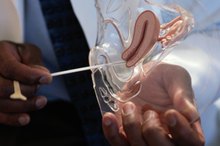Exercises for a Retroverted Uterus
A tilted uterus is a normal anatomical variation that affects 20 percent of all women 1. Normally, the uterus is located straight up and down, or tips slightly forward, however, in retroversion of the uterus, the uterus tilts backwards at the cervix. This anatomically variation may be caused by pelvic inflammatory disease, weak uterine ligaments, multiple pregnancies or endometriosis. Strengthening the ligaments and muscles in your pelvic wall can help reposition your uterus into the forward position. Consult with your physician before beginning an exercise program.
If you are experiencing serious medical symptoms, seek emergency treatment immediately.
Kegal Exercises
Your pelvic floor muscles and ligaments hold your uterus in place. Multiple pregnancies weaken the muscles and ligaments in your pelvic floor, causing your uterus to tilt backwards at the cervix. Kegal exercises strengthen these muscles and help reposition your uterus to the forward position. Identify your pelvic floor muscles by inserting a finger inside your vagina. Contract your vaginal wall muscles or the muscles surrounding your inserted finger. If done properly, you should feel your pelvic floor move upward during each contraction. Relax the contraction of your vaginal walls and you should feel pelvic floor muscles move down. Perform five contractions in a row, holding each contraction for 10 seconds and relaxing for 10 seconds in between each contraction. Perform one set of 10 repetitions, three times daily, to strengthen your pelvic floor muscles and help reposition your uterus.
- Your pelvic floor muscles and ligaments hold your uterus in place.
Knee to Chest
Knee and Chest Exercises for a Tipped Uterus
Learn More
This exercise can help reposition a tilted uterus to the forward position. Begin by lying backwards on a flat surface. Bend both knees and plant your feet firmly on the floor. While keeping your left foot flat on the floor, bring your right knee to your chest. Hold this position for 15 to 30 seconds, and return your leg to the starting position. Perform one set of 10 repetitions on both legs, three times a day.
- This exercise can help reposition a tilted uterus to the forward position.
- Bend both knees and plant your feet firmly on the floor.
Kangaroo Walk
The kangaroo walk is an exercise that strengthens the erector spinea muscles in your lower back and repositions the uterus to the forward position by a to and fro movement. Begin this exercise by getting on all fours. Straighten your arms and lift your hips toward the ceiling. Push your abdomen forward by keeping your knees slightly flexed and your back slightly arched. Walk on all fours with your knees slightly bent. As you perform this kangaroo walk, your uterus is pulled extremely forward in each step. Substantial results can be obtained by performing this exercise for a few minutes per day.
- The kangaroo walk is an exercise that strengthens the erector spinea muscles in your lower back and repositions the uterus to the forward position by a to and fro movement.
- Push your abdomen forward by keeping your knees slightly flexed and your back slightly arched.
Consideration
Exercises for Contracted Muscles Behind the Knee
Learn More
Strengthening your abdominal and pelvic floor muscles is the best way to reposition a tilted uterus. Since a tilted uterus is typically caused by weakened muscles and ligaments due to multiple pregnancies, any exercise that targets these muscles and removes excess stress from the uterine ligaments can help reposition a tilted uterus. If your tilted uterus is due to endometriosis, pelvic infections or fibroid tumors, these exercise may not be effective. Your physician may recommend a uterine suspension, a surgically procedure to reposition your uterus if you experience pain during menstruation or intercourse. Speak with your physician about your treatment options.
- Strengthening your abdominal and pelvic floor muscles is the best way to reposition a tilted uterus.
Related Articles
References
- The American Pregnancy Association; Tipped Uterus: Tilted Uterus; November 2007
- Mayo Clinic; Kegel Exercises; June 2010
- Health.com; Knee-to-Chest Exercise; February 2010
- "Texas State Journal of Medicine"; Movable Retro-Positions of the Uterus, Their Mechanism and Significance; Minnie C. O'Brien M.D.; 1920
- UT Southwestern Medical Center. What’s going on with my uterus? 3 conditions related to pelvic pain and bleeding. Updated September 27, 2018.
- Cleveland Clinic. Menorrhagia (heavy menstrual bleeding). Updated March 8, 2018.
- Centers for Disease Control and Prevention. Pelvic inflammatory disease (PID) — CDC factsheet. Updated December 11, 2015.
- Cleveland Clinic. Uterine polyps. Updated September 28, 2018.
- Cleveland Clinic. Atypical endometrial hyperplasia. Updated June 25, 2017.
- NIH National Institute of Child Health and Human Development. What are the symptoms of endometriosis? Updated January 31, 2017.
- Cleveland Clinic. Asherman’s syndrome. Updated June 29, 2017.
- Centers for Disease Control and Prevention. Uterine cancer. What are the symptoms? Updated August 9, 2019.
- Speer LM, Mushkbar S, Erbele T. Chronic pelvic pain in women. American family physician. 2016;93(5):380-7.
- Centers for Disease Control and Prevention. Common reproductive health concerns for women. Updated April 27, 2018.
- NIH National Institute of Child Health and Human Development. What are the treatments for endometriosis? January 31, 2017.
- Harvard Medical School Harvard Health Publishing. Ask the doctor: Heavy bleeding, fibroids, and polyps. Updated May 14, 2019.
- Cleveland Clinic. Vaginal and uterine prolapse: Management and treatment. Updated November 30, 2015.
- Penn Medicine. Mullerian anomalies.
- UT Southwestern Medical Center. What’s going on with my uterus? 3 conditions related to pelvic pain and bleeding. Updated September 27, 2018.
- Gossman W, Fagan SE, Sosa-Stanley JN, et al. Anatomy, abdomen and pelvis, uterus. In: StatPearls. Updated July 11, 2019.
- Penn State Hershey. Milton S. Hershey Medical Center. Menstrual disorders. Updated September 29, 2017.
- Sharghi M, Mansurkhani SM, Ashtary-Larky D, et al. An update and systematic review on the treatment of primary dysmenorrhea. JBRA Assist Reprod. 2019;23(1): 51–57. doi:10.5935/1518-0557.20180083
- Cleveland Clinic. Menorrhagia (heavy menstrual bleeding). Updated March 8, 2018.
- Chung S, Kim WB. Various approaches and treatments for pelvic organ prolapse in women. J Menopausal Med. 2018;24(3):155-. doi:10.6118/jmm.2018.24.3.155
- UNC Department of Obstetrics & Gynecology. Pelvic relaxation and retroverted uterus.
- Saravelos SH, Cocksedge KA, Li T. The pattern of pregnancy loss in women with congenital uterine anomalies and recurrent miscarriage. Reproductive BioMedicine Online. 2010;20(3):416-422. doi:10.1016/j.rbmo.2009.11.021
- Colombia University Irving Medical Center. Uterine anomaly.
- Centers for Disease Control and Prevention. Pelvic inflammatory disease (PID) — CDC factsheet. Updated December 11, 2015.
- Cleveland Clinic. Uterine polyps. Updated September 28, 2018.
- UCLA Health. What are fibroids.
- Cleveland Clinic. Atypical endometrial hyperplasia. Updated June 25, 2017.
- NIH National Institute of Child Health and Human Development. What are the symptoms of endometriosis? Updated January 31, 2017.
- Cleveland Clinic. Asherman’s syndrome. Updated June 29, 2017.
- Centers for Disease Control and Prevention. Uterine cancer. What are the symptoms? Updated August 9, 2019.
- Speer LM, Mushkbar S, Erbele T. Chronic pelvic pain in women. American family physician. 2016;93(5):380-7.
- U.S. Department of Health & Human Services. Vaginal discharge.
- Centers for Disease Control and Prevention. Common reproductive health concerns for women. Updated April 27, 2018.
- Pinkerton JV, Guico-Pabia CJ, Taylor HS. Menstrual cycle-related exacerbation of disease. American Journal of Obstetrics and Gynecology. 2010;202(3):221-231. doi:10.1016/j.ajog.2009.07.061
- Planned Parenthood. What is a pelvic exam?
- Planned Parenthood. Pap smear test.
- MedlinePlus. Urinalysis.
- MedlinePlus. Hormone levels.
- Wong L, White N, Ramkrishna J, Júnior EA, Meagher S, Costa FDS. Three-dimensional imaging of the uterus: The value of the coronal plane. WJR. 2015;7(12):484-. doi:10.4329/wjr.v7.i12.484
- Acholonu UC, Silberzweig J, Stein DE, Keltz M. Hysterosalpingography versus sonohysterography for intrauterine abnormalities. JSLS. 2011;15(4):471-474. doi:10.4293/108680811X13176785203923
- NIH National Institute of Child Health and Human Development. What are the treatments for endometriosis? January 31, 2017.
- Harvard Medical School Harvard Health Publishing. Ask the doctor: Heavy bleeding, fibroids, and polyps. Updated May 14, 2019.
- Cleveland Clinic. Vaginal and uterine prolapse: Management and treatment. Updated November 30, 2015.
- Penn Medicine. Mullerian anomalies.
- Cleveland Clinic. Hysteroscopy. Updated July 18, 2018.
Resources
Writer Bio
Danielle Stevens is a graduate of George Washington School of Medicine and is currently a resident fellow at Georgetown University Hospital. Stevens is interested in pediatrics and gynecology as well as pediatric surgery. Stevens has been writing professionally since 2008 for The American College of Obstetricians and Gynecologists, Words and Numbers, and Prime Inc.








